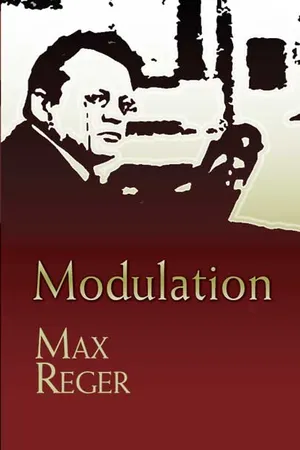eBook - ePub
Modulation
About this book
"I consider him a genius," remarked Arnold Schoenberg of the progressive early modernist Max Reger (1873–1916). In addition to his international renown as a teacher, conductor, and pianist, Reger wrote more than 1,000 works in virtually every musical genre. Many scholars and musicians credit him with emancipating dissonance to a level that assisted Schoenberg's development of serialism in the 1920s. Reger's influence extends to other 20th-century composers, including Béla Bártok, Alban Berg, Arthur Honegger, Paul Hindemith, and Sergei Prokofiev.
Modulation — the change from one key to another — is a subject of critical importance to performers and composers in their study of harmony. Reger wrote this concise guide to modulation while teaching composition at Leipzig Conservatory, and the work continues to provide valuable insights and instruction for musicians at all levels. This new edition features newly engraved musical examples.
Modulation — the change from one key to another — is a subject of critical importance to performers and composers in their study of harmony. Reger wrote this concise guide to modulation while teaching composition at Leipzig Conservatory, and the work continues to provide valuable insights and instruction for musicians at all levels. This new edition features newly engraved musical examples.
Frequently asked questions
Yes, you can cancel anytime from the Subscription tab in your account settings on the Perlego website. Your subscription will stay active until the end of your current billing period. Learn how to cancel your subscription.
No, books cannot be downloaded as external files, such as PDFs, for use outside of Perlego. However, you can download books within the Perlego app for offline reading on mobile or tablet. Learn more here.
Perlego offers two plans: Essential and Complete
- Essential is ideal for learners and professionals who enjoy exploring a wide range of subjects. Access the Essential Library with 800,000+ trusted titles and best-sellers across business, personal growth, and the humanities. Includes unlimited reading time and Standard Read Aloud voice.
- Complete: Perfect for advanced learners and researchers needing full, unrestricted access. Unlock 1.4M+ books across hundreds of subjects, including academic and specialized titles. The Complete Plan also includes advanced features like Premium Read Aloud and Research Assistant.
We are an online textbook subscription service, where you can get access to an entire online library for less than the price of a single book per month. With over 1 million books across 1000+ topics, we’ve got you covered! Learn more here.
Look out for the read-aloud symbol on your next book to see if you can listen to it. The read-aloud tool reads text aloud for you, highlighting the text as it is being read. You can pause it, speed it up and slow it down. Learn more here.
Yes! You can use the Perlego app on both iOS or Android devices to read anytime, anywhere — even offline. Perfect for commutes or when you’re on the go.
Please note we cannot support devices running on iOS 13 and Android 7 or earlier. Learn more about using the app.
Please note we cannot support devices running on iOS 13 and Android 7 or earlier. Learn more about using the app.
Yes, you can access Modulation by Max Reger in PDF and/or ePUB format, as well as other popular books in Media & Performing Arts & Classical Music. We have over one million books available in our catalogue for you to explore.
Information
Analysis of the Examples in Modulation
A. From C-major to:
1) G-major | 2) D-major |

1) G-major
Tonic C-major; use this C-major which is at the same time the sub-dominant of G-major. (Cadence!)

2) D-major
Tonic C-major; relative (e-minor) to the dominant (G-major) of C-major; use this e-minor (1st inversion), which is also relative to the sub-dominant (G-major) of D-major. (Cadence!)

3) A-major | 4) E-major |

3) A-major
Tonie C-major; relative (d-minor) to the sub-dominant (F-major) of C-major; use this d-minor, which is at the same time the minor sub-dominant of A-major. (Cadence!)

4) E-major
Tonic C-major; relative (a-minor) to the tonic of C-major; use this a-minor, which is at the same time the minor sub-dominant of E-major. (Cadence!)

5) B-major | 6) F♯-major |

5) B-major
Tonic C-major; relative (e-minor) to the dominant (G-major) of C-major; use this e-minor, which is also the minor sub-dominant in B-major. (Cadence!)

6) F♯-major
Tonic C-major; dominant G-major; the 1st inversion of which is used (the chord of the sixth, b d g), which is at the same time the chord of the Neapolitan sixth*) in F♯-major. (Cadence!)

7) C♯-major | 8) G♯-major |

7) C♯-major
Tonic C-major; relative (e-minor) to the dominant (G-major) of C-major; use this e-minor, which is also the minor sub-dominant of B-major; dominant (F♯-major) of B-major; use this F♯-major, which is at the same time sub-dominant in C♯-major. (Cadence!)

8) G♯-major
Tonic C-major; relative (d-minor) to the sub-dominant (F-major) of C-major; dominant (A-major) of d-minor; use the 1st inversion of this A-major (the chord of the sixth, c♯ e a), which is also the chord of the Neapolitan sixth in G♯-major. (Cadence!)

9) D♯-major

Tonic C-major; relative (d-minor) to the sub-dominant (F-major) of C-major; use this d-minor, which is at the same time sub-d...
Table of contents
- Cover
- Title Page
- Copyright Page
- Contents
- Preliminary Remarks
- Analysis of the Examples in Modulation
- B. From C#-major to
- C. From a-minor to
- D. From Cb-major to
- E. From db-minor to
- F. From a#-minor to
